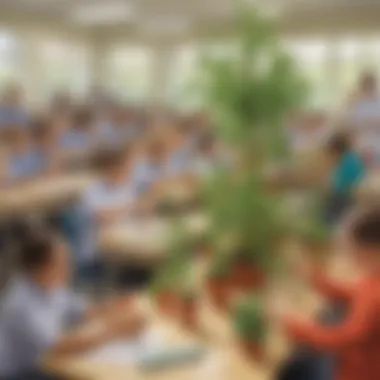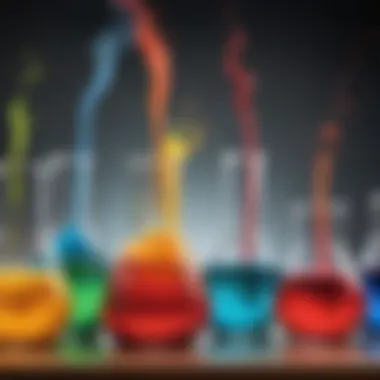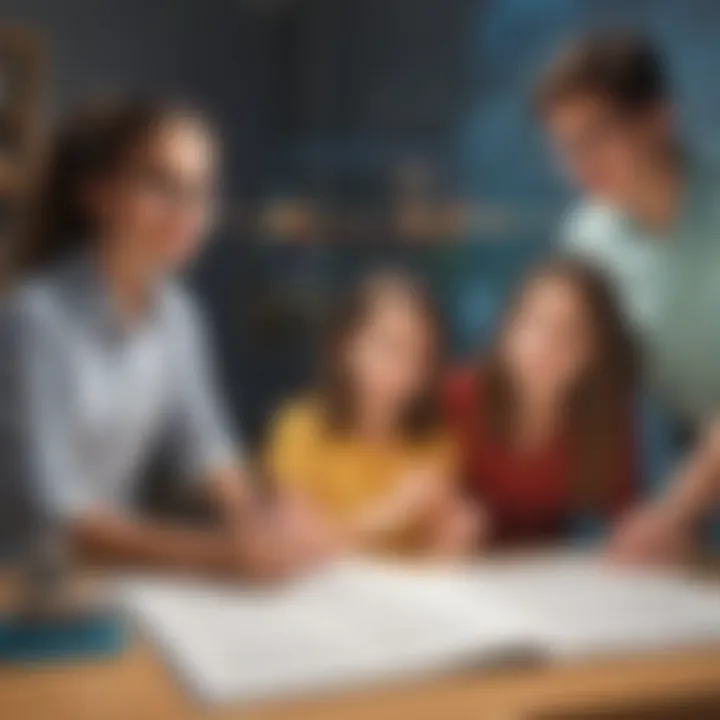Engaging Science Experiments for Fourth Graders


Intro
In the world of education, engaging students, especially those in fourth grade, can often be a formidable challenge. Science offers a unique opportunity to combine curiosity with hands-on experiments. This article will explore a variety of science experiments tailored for fourth graders. The focus will be on the essential concepts in biology, chemistry, physics, and environmental science. Each experiment is designed not only to captivate young minds but also to provide a practical understanding of scientific principles. This resource serves to guide educators and parents alike in implementing activities that enhance learning and promote a deeper interest in science.
Creative Activities
Science can be more than just theoretical; it's about crafting experiences that pupils can easily engage with. Here, creativity thrives alongside educational value. The following ideas offer straightforward ways to captivate fourth graders.
Craft Ideas
Hands-on craft ideas are effective in digging deeper into scientific concepts. Consider activities like creating a model of the solar system using foam balls or constructing a simple circuit with batteries and LED lights. Crafting greenhouses from recycled materials can serve as an engaging method to discuss plant biology and ecosystems.
Step-by-Step Guides
For each activity, clear step-by-step instructions ensure that children understand the process. For example, while making a mini volcano, follow these steps:
- Gather Materials: You will need baking soda, vinegar, dish soap, food coloring, and a container.
- Create Your Volcano: Shape playdough around the container to form the volcano.
- Add Ingredients: Pour a few spoonfuls of baking soda into the container.
- Erupt: Mix vinegar with a drop of dish soap and food coloring, then pour into the volcano. Observe the eruption.
Educational Value
Engaging in such activities not only fuels creativity but also instills critical thinking. Students learn about chemical reactions and the principles that govern them. They also gain experience in scientific observation, which is crucial for their educational journey.
Fun Quizzes
Integrating quizzes within the learning process can solidify knowledge. Quizzes serve as tools for reinforcing concepts learned through experiments.
Quiz Topics
The quizzes might cover a wide range of topics, such as:
- Basic biology and ecosystems.
- Physics principles like motion and energy.
- Chemistry fundamentals related to reactions and mixtures.
Question Types
To maintain engagement, a variety of question types can be used, including:
- Multiple choice questions that test recall and understanding.
- Fill-in-the-blank questions that require students to think critically.
- True or false statements to assess comprehension.
Knowledge Reinforcement
Such quizzes not only check student knowledge but also aid retention. They encourage students to revisit concepts and enhance recall through repetition.
Fact-Based Articles
Providing access to fact-based articles enriches students' understanding.
Topics
A diverse range of topics can include:
- The structure of cells and their functions.
- Fundamental physics laws and their applications.
- Environmental issues and sustainability practices.
Engaging Content
The articles should present information in a straightforward manner. Short paragraphs with clear headings can make reading easier. Illustrated graphics can also help in explaining complex topics.
Prelims to Science Experiments
Science experiments serve as a vital gateway for fourth graders to engage actively with the world around them. Understanding scientific principles through direct engagement enables children to grasp complex concepts more naturally and effectively. This article delves into a variety of experiments across multiple scientific disciplines, each curated to spark curiosity and deepen understanding.
Conducting experiments provides numerous benefits for young learners. Firstly, hands-on activities promote critical thinking and problem-solving skills. As students formulate hypotheses, design experiments, and analyze their results, they learn to approach questions with a scientific mindset. This process helps them connect theoretical concepts with practical applications.
Furthermore, the act of experimenting fosters a sense of wonder and exploration. Children learn that science is not just about memorizing facts but also about observing, questioning, and discovering new information.
"Engaging with science allows children to see its relevance in everyday life."
Additionally, science experiments can enhance collaboration among peers. Working in groups encourages teamwork, communication, and respect for diverse ideas. They also provide opportunities for discourse, where students can articulate their thoughts and challenge each other’s perspectives.
While the joy of discovery is immense, it is essential for educators and parents to approach science experiments thoughtfully. Considerations include ensuring age-appropriate content, providing proper resources, and prioritizing safety protocols. Introducing these concepts to children at a young age lays the groundwork for future scientific endeavors. Therefore, fostering an enriching environment for science experiments can ignite lasting interest in the field.
Importance of Hands-On Learning
Hands-on learning is vital for children, especially for fourth graders. At this age, students are developing their cognitive skills and the ability to understand complex concepts. Engaging students in hands-on activities helps to solidify these concepts and allows them to explore ideas actively. By participating in experiments, children can see scientific principles in action rather than just reading about them in a textbook.
Benefits of Hands-On Learning
- Enhances Engagement: Children often find traditional methods of learning less interesting. Hands-on experiments can ignite a child's curiosity and encourage them to learn more. When they interact directly with materials or subjects, their interest can significantly increase.
- Improves Retention: Research shows that students remember information better when they learn through applied activities. This practical approach allows for direct experience, making it easier to recall information during tests or discussions.
- Develops Critical Thinking: Hands-on learning promotes critical thinking skills. Students are challenged to hypothesize what will happen in an experiment, analyze the outcomes, and reflect on their findings. This scientific methodology cultivates a deeper understanding of the subject matter.
- Fosters Teamwork and Communication: Many science experiments are performed in groups. This collaboration helps students to work as a team, sharing ideas and discussing results. Communication skills enhance as they explain their thoughts or findings with classmates, which is crucial in daily life.
- Encourages Independence: Honing hands-on skills often leads to increased independence. Children gain confidence when working through problems, learning to make decisions, and sometimes even troubleshooting issues during an experiment.
Considerations About Hands-On Learning
When implementing hands-on experiments, it is crucial to keep a few considerations in mind:
- Instruction: Clear guidance is necessary to help students understand procedures and safety precautions. This instruction enhances learning and reduces the risk of accidents.
- Materials: Selecting age-appropriate materials is vital. Experiments should be accessible so that all students can engage effectively.
- TimeManagement: Teachers and parents should plan the timing of the experiments to ensure that students have enough time to understand each part of the process.
- Reflection: After experiments, encouraging students to discuss their experiences and observations can reinforce learning and foster analytical thinking.
"Engaging students in hands-on learning promotes curiosity, enhances retention, and develops essential life skills."
In summary, the importance of hands-on learning is substantial, especially for fourth graders. It not only deepens their scientific understanding but also supports personal and social skills critical for their development. Providing such experiences can lead to a lifelong interest in science and exploration.
Safety Considerations for Young Experimenters
When it comes to science experiments, safety is a primary concern, especially for young learners. Fourth graders are curious and enthusiastic, which can sometimes lead to forgetfulness about safety protocols. Creating a safe environment is crucial in order to foster not just learning, but also a sense of responsibility and care towards scientific practices. Proper emphasis on safety considerations helps prevent injuries and instills a code of conduct for future learning experiences. Ensuring that students understand safety measures enhances their ability to focus on the scientific principles being taught without distractions or hazards.
Essential Safety Equipment
Specific safety equipment is important for any science experiment. Here are essential items you should consider for young experimenters:
- Safety Goggles: Protecting eyes is vital, especially when working with liquids or substances that can splatter.
- Gloves: Disposable gloves are helpful in minimizing skin contact with chemicals or messy materials.
- Aprons: A lab apron or old shirt can prevent contamination of clothing and serve as an additional layer of protection.
- First Aid Kit: Having a readily available first aid kit ensures that any minor accidents can be handled promptly.
These items support safety and help create an environment where children feel secure while exploring.


Guidelines for Safe Experimentation
Setting clear guidelines for safe experimentation is key to successful learning experiences. Here are some suggested rules:
- Adult Supervision: Always conduct experiments under adult supervision to ensure proper guidance and immediate response in case of accidents.
- Read Instructions Carefully: Before starting any experiment, it is important to read all directions thoroughly to understand the steps and potential hazards involved.
- Label Materials Properly: Always label all materials and chemicals clearly to avoid confusion and accidental misuse.
- Clean Up Properly: After completing experiments, it's essential to clean up all materials and dispose of waste according to guidelines. This prevents contamination and accidents in future experiments.
- Report Accidents Immediately: If any spills or accidents occur, they should be reported immediately to an adult. This ensures quick action can be taken to mitigate any dangers.
Following these guidelines not only promotes safety but also teaches students the importance of responsibility while conducting scientific investigations.
By prioritizing safety considerations, educators and parents create a supportive atmosphere for young experimenters. This fosters confidence and curiosity, encouraging children to explore the fascinating world of science.
Biology Experiments
Biology experiments serve as a crucial component of science education for fourth graders. They ignite an interest in the living world and help young learners understand fundamental biological concepts. Engaging in hands-on biology experiments fosters curiosity and encourages students to observe nature closely. Through these experiments, they learn basic life processes, relationships among organisms, and the importance of ecosystems.
These activities also have educational benefits. They promote problem-solving skills, critical thinking, and teamwork. For example, students working together on an experiment gain skills in collaboration and communication. Furthermore, constructing hypotheses based on observations helps to develop an analytical mindset.
Plant Growth Observations
Studying plant growth is a powerful way to introduce young learners to biology. This activity allows children to observe how plants grow under various conditions. Plant growth observations can cover factors such as light, water, and soil type. By manipulating these variables, students can see firsthand how each element affects plant development.
To conduct this experiment, children can choose a few different types of plants. They could use seeds from beans, sunflower, or any easily obtainable plant. Then, they can plant these seeds in pots and place them in areas with different levels of sunlight exposure. Some plants might receive a lot of light, while others receive very little or indirect light.
Key Steps:
- Gather seeds, soil, pots, and water.
- Plant the seeds in the pots with soil.
- Choose varying light conditions for each pot.
- Water the plants regularly.
- Measure and document growth every few days.
By keeping a growth journal, students can track changes over time. They will learn to recognize patterns in nature, and this observation method instills a sense of responsibility towards nurturing living things.
Ecosystem in a Bottle
The Ecosystem in a Bottle experiment provides a microcosm for children to appreciate environmental science. It enables them to see how different components interact within an ecosystem. This experiment can help them understand cycles, such as the water cycle and food chains.
To create an ecosystem in a bottle, students need a clear plastic bottle or jar, some soil, small plants, and a few small aquatic organisms like snails or tiny fish. The idea is to create a closed environment where the organisms can coexist.
Instructions:
- Start by adding a layer of small rocks at the bottom for drainage.
- Layer soil on top of the rocks. This will serve as the foundation for plant growth.
- Plant the small plants securely in the soil.
- Add a small amount of water, enough to maintain moisture but not drowning the plants.
- If using aquatic creatures, ensure they are added to a separate water environment.
Over time, students will observe how plants produce oxygen while consuming carbon dioxide. They will witness nutrient cycles in action, and how each organism plays a role in maintaining the ecosystem's balance. This experiment sparks wonder and a desire to protect the environment.
"By understanding ecosystems, students can comprehend the importance of biodiversity and conservation efforts."
Engaging in biology experiments like Plant Growth Observations and Ecosystem in a Bottle enhances critical thinking. These are vital in shaping responsible and knowledgeable future scientists.
Chemistry Experiments
Chemistry holds a captivating role in understanding the composition and behavior of matter. This section aims to unveil the significance of chemistry experiments in shedding light on scientific principles. Chemistry is all around us and influences our daily lives in various ways. For fourth graders, engaging with chemistry experiments can inspire curiosity and enable hands-on learning with fascinating reactions.
The primary benefits of chemistry experiments are their ability to demonstrate observable outcomes that illustrate scientific concepts. They encourage students to engage in critical thinking and problem-solving. Furthermore, these experiments teach the fundamental principles of reactions, mixtures, and states of matter in a way that is both entertaining and educational.
It's also essential to consider that chemistry experiments can be safely conducted at home or in school. They encourage teamwork and collaboration among students, which can lead to a deeper understanding of the material covered in the classroom.
Overall, chemistry experiments serve as a compelling gateway to enrich young learners' educational experiences.
Vinegar and Baking Soda Reaction
The reaction between vinegar and baking soda stands as one of the most popular chemistry experiments for elementary students. This simple experiment demonstrates an acid-base reaction, which results in the production of carbon dioxide gas. The visual effects of bubbling and fizzing are exciting for children, making it an excellent choice to capture their attention.
Materials Needed:
- Baking soda
- Vinegar
- Container (like a small cup or bowl)
- Food coloring (optional for visual enhancement)
Steps to Conduct the Experiment:
- Place a few tablespoons of baking soda in the container.
- Add food coloring if desired for a colorful reaction.
- Slowly pour vinegar over the baking soda.
- Observe the reaction!
During this experiment, students can note the rapid fizzing and bubbling, observing how gas is produced. Some questions to consider include:
- What happened when vinegar met baking soda?
- Can we collect the gas produced?
This experiment provides a clear demonstration of chemical reactions, specifically how an acid interacts with a base to produce gas.
Homemade Lava Lamp
Creating a homemade lava lamp is an enthralling way to explore density and immiscibility of liquids. This experiment allows students to visualize chemical reactions in liquid form while sparking excitement through color and motion.
Materials Needed:
- Clear plastic bottle
- Water
- Vegetable oil
- Food coloring
- Alka-Seltzer tablet
Steps to Conduct the Experiment:
- Fill the bottle partly with water.
- Add a generous amount of vegetable oil on top of the water. Notice how the oil and water do not mix.
- Add a few drops of food coloring. Observe how the food coloring interacts with the water below.
- Break an Alka-Seltzer tablet into pieces and add one piece to the bottle.
- Watch the bubbling motion!
This experiment showcases how different liquids can have different densities. The Alka-Seltzer tablet reacts with water, producing carbon dioxide. Students can discuss why the colored water rises and falls while the oil remains on top.
In both of these experiments, children not only have the opportunity to see science in action but also learn the importance of observation and experimentation. As they engage in these hands-on activities, their understanding of chemistry deepens, fostering a lifelong interest in science.
Physics Experiments
Physics experiments are vital for young learners. They show how the world around us operates through forces, energy, and motion. By engaging in these experiments, fourth graders build essential skills such as critical thinking and problem-solving. Understanding physics can also promote an appreciation for scientific inquiry. Not only does it help students grasp complex concepts, but it also encourages curiosity about natural phenomena. Here, we will explore two exciting physics experiments that are suitable for fourth graders.
Building Simple Machines
The exploration of simple machines introduces students to fundamental physical concepts in an engaging way. Simple machines include levers, pulleys, inclined planes, wedges, and screws. These devices make work easier by allowing us to use force more effectively. For instance, when creating a lever, students can learn about the balance of forces and how leveraging a small force can move a heavier object.
Materials Needed:
- A ruler or a long piece of wood
- A small block or any object to lift
- A fulcrum, which can be a small cylinder or a stack of books
Steps to Perform the Experiment:


- Place the ruler on the fulcrum.
- Position the block at one end of the ruler.
- Push down on the other end of the ruler. Observe how the position of the fulcrum affects the amount of force needed to lift the block.
By conducting this experiment, children can visualize the principles of leverage and force. They learn that increasing the distance from the fulcrum reduces the force required to lift the load. This concept applies to a wide range of real-world situations, making physics tangible.
Exploring Forces with a Balloon Rocket
Another engaging physics experiment involves the use of a balloon to investigate forces. This experiment also relates to Newton's Third Law, which states that for every action, there is an equal and opposite reaction. Balloon rockets illustrate this principle vividly.
Materials Needed:
- A long balloon
- A straw
- String
- Tape
- A pair of scissors
Steps to Perform the Experiment:
- Cut a length of string and tie it between two chairs or other stable objects.
- Thread the straw onto the string before securing it in place.
- Inflate the balloon but do not tie it. Instead, tape it to the straw.
- Release the balloon without tying it, allowing the air to escape. Watch as the balloon moves along the string.
Through this experiment, students can observe how releasing air from the balloon propels it forward. It’s a great way to discuss concepts like force, motion, and the properties of air.
These physics experiments not only foster scientific knowledge but also promote collaboration and communication among peers as they work together to solve problems. Understanding these principles lays the groundwork for more advanced studies in physics, ultimately encouraging a lifelong interest in science.
Environmental Science Experiments
Environmental science experiments play a crucial role in educating fourth graders about their surroundings. These experiments help children understand vital concepts like ecosystems, conservation, and sustainability. At this age, students are naturally curious, making it the perfect time to introduce them to the principles of environmental science.
By engaging in environmental experiments, children develop a sense of responsibility towards nature. This kind of learning promotes critical thinking as they assess the environmental impact of their actions. Moreover, it encourages them to explore the delicate balance of natural systems. Understanding such concepts at a young age fosters an attitude of stewardship, helping to cultivate future generations of environmentally conscious citizens.
Engaging in hands-on activities like water filtration and compost creation allows for meaningful learning experiences. These experiments not only provide practical knowledge but also enhance students’ observational skills and scientific reasoning. They bring abstract concepts into a tangible format, relevant to the students' lives.
"Learning about environmental science through hands-on experiments can inspire fourth graders to make a difference in their local ecosystems."
Water Filtration Experiment
The water filtration experiment is a simple yet impactful way to demonstrate how clean drinking water is essential for health and survival. This activity allows students to see firsthand how pollutants affect water quality and the effectiveness of filtration methods.
Materials Needed:
- Clear plastic bottles
- Sand
- Gravel
- Activated charcoal
- Coffee filter or cheesecloth
- Contaminated water sample (can simply be muddy water)
Procedure:
- Cut the plastic bottle in half and use the top part as a funnel.
- Place the coffee filter at the neck of the bottle.
- Layer the sand, gravel, and activated charcoal in that order.
- Pour the contaminated water through the filter.
- Observe the filtration process and examine the clarity of the filtered water.
This experiment illustrates the concept of natural water filtration, and it encourages discussions about water pollution and ways to maintain clean water sources in the community. Through this exercise, students learn not only about science but also the importance of environmental conservation.
Creating Compost
Creating compost is another effective experiment to teach fourth graders about recycling organic materials and enriching soil. This hands-on activity reinforces concepts of decomposition and nutrient cycling within ecosystems. Students will learn how to turn kitchen waste into valuable fertilizer for plants.
Materials Needed:
- A compost bin (or a pile in a suitable area)
- Kitchen scraps (fruits, vegetables, coffee grounds)
- Yard waste (leaves, grass clippings, small branches)
- Soil or finished compost (to introduce microorganisms)
Procedure:
- Layer kitchen scraps and yard waste in the compost bin.
- Add a layer of soil or finished compost to help with decomposition.
- Turn the compost pile every few weeks to aerate it.
- Discuss the observations over time as the materials break down.
This experiment not only highlights how waste can be repurposed but also connects students to larger environmental issues like landfills and organic farming. As students engage in this process, they become more aware of their consumption habits and the benefits of reducing waste.
By integrating these environmental science experiments into the curriculum, educators can promote a deeper understanding of ecological principles while also nurturing a sense of environmental responsibility in young learners.
Integrating Technology in Science Experiments
Integrating technology into science experiments enhances the learning process for fourth graders. Technology offers numerous benefits, including increased engagement, access to real-time data, and improved analytical skills. As students interact with various tools, they not only learn scientific concepts but also develop skills that are essential in today’s digital age. This approach makes science appealing and allows young learners to experience a sense of accomplishment as they observe results through a technological lens.
Incorporating technology into experiments allows students to collect and analyze data efficiently. It also enables them to document their findings in a more organized manner. Students can work with various tech tools, from smartphones to tablets, making science accessible in different environments.
Using Apps for Scientific Data Collection
Mobile applications designed for scientific data collection can significantly enhance a student's ability to engage with experiments. These apps can help students gather data visually using graphs and charts, providing immediate feedback on their observations.
Here are some reasons why using apps is beneficial:
- User-Friendly Interfaces: Many apps are designed with an intuitive layout that is suitable for children. This makes navigation simple, encouraging exploration.
- Immediate Analysis: Apps often come with tools for real-time data analysis, allowing students to grasp concepts quicker and apply their understanding immediately.
- Engagement Through Gamification: Some apps incorporate gamified elements, making science more enjoyable while still educational.
When using apps, it's essential to choose ones that align with the curriculum and the experiments. Options such as Science Journal or Phylo, for instance, aid in tracking data effectively and can be tailored for various scientific principles.
Monitoring Experiments with Sensors
Sensors are valued tools in the realm of science experiments that align with technology integration. These devices provide precise measurements and real-time monitoring, which is vital for the scientific method.
Some advantages of using sensors are:
- Accuracy: Sensors provide accurate readings, which help students understand variables in their experiments more deeply.
- Real-Time Feedback: Students can see how changes affect outcomes as they experiment, facilitating an iterative learning process.
- Hands-On Learning: Working with sensors supports kinesthetic learning. Students engage physically and mentally with the material.
Using sensors, such as temperature or pH meters, allows for experiments that require specific measurements. By utilizing platforms like Arduino or Raspberry Pi, students can create their own projects, thus enhancing creativity and problem-solving skills.
Integrating technology into science experiments not only makes learning fun but also prepares students for future scientific endeavors.
In summary, technology's integration into science experiments is pivotal for fourth graders. It allows for effective data collection and monitoring while fostering students’ analytical abilities. Parents and educators should embrace these innovations, ensuring that children achieve a deeper understanding of scientific principles.
Recommended Resources and Materials
In the realm of science experimentation for fourth graders, having the right resources and materials is essential. These resources not only facilitate hands-on experimentation but also provide a solid foundation for understanding scientific principles. Parents and educators should consider diverse materials that enhance learning experiences. Books and online platforms serve as integral tools in guiding students through their exploratory journey. They capture attention while instilling a sense of curiosity towards science.
Books on Science Experiments
Books offer structured information and systematic approaches to scientific experiments. They can vary in complexity, catering to different skill levels and interests. A good book will present clear instructions alongside detailed explanations of the underlying concepts. Popular titles include "The Curious Kid's Science Book" by Asia Citro or "National Geographic Kids Science Fair Explorer". These texts are not only informative but often contain illustrations that engage young minds.
- Benefits of Science Experiment Books:


- Illustrated Guides: Visual aids help students understand complex concepts.
- Variety of Experiments: Wide range of topics from various scientific fields.
- Step-by-Step Instructions: Clear guidance encourages successful experiments without frustration.
When selecting books, consider the child's interests. For example, a child fascinated by insects may benefit from a biology-focused experiment book. This targeted approach enhances engagement and retention of information.
Online Platforms for Experimentation Guidance
The digital age has made science accessible through various online platforms. Websites like National Geographic Education, Science Buddies, and TED-Ed provide valuable resources. These platforms often feature experiments that are easily replicable, along with educational videos and interactive tutorials.
"Online resources make science experiments accessible and exciting for young learners."
- Advantages of Online Platforms:
- Interactive Content: Videos and animations engage students more effectively than static images.
- Community Support: Many platforms have forums where kids can interact and share results with peers.
- Variety of Formats: Offers articles, videos, and even quizzes to reinforce learning.
Utilizing resources from both books and online platforms not only aids in conducting experiments but also helps students understand science deeply. By fostering a conducive learning environment, children can build a strong foundation in scientific inquiry, enhancing their overall educational experience.
Encouraging Scientific Curiosity Outside the Classroom
Encouraging scientific curiosity outside the classroom is crucial for reinforcing what students learn during their formal education. It allows children to explore science in a familiar environment, fostering a lasting interest in the subject. This exploration expands their understanding by connecting theory to real-world situations. It also nurtures critical thinking and observational skills, which are essential in scientific inquiry.
When children explore science outside the classroom, they engage more deeply with concepts. Observing the world around them can spark questions. For instance, a child might wonder why leaves change color in the fall or how rain forms. Each question can lead to an experiment or investigation, turning a simple walk in the park into a valuable learning experience. The benefits of such exploration are manifold. They include:
- Enhanced understanding of scientific principles: Students can relate classroom concepts to observations in their daily lives.
- Creativity and innovation: Exploring freely allows for imaginative thinking and unique questions.
- Development of perseverance: Encountering challenges and solving them builds resilience.
Parents and caregivers should create opportunities for scientific exploration. This can be done by encouraging children to ask questions, seek answers, and conduct small experiments. It is a practical way to engage with science and instill a lifelong curiosity.
"The greatest gift you can give your children is the roots of responsibility and the wings of independence."
— Johann Wolfgang von Goethe
Science Exploration at Home
Science exploration at home can be as simple as turning everyday activities into experiments. Cooking, for example, is a great way to introduce concepts of chemistry and biology, like reactions and changes in matter. Cooking can teach measurements, reactions, and the science behind food.
Activities like growing plants also enhance understanding. Kids can plant seeds in pots and observe their growth over time. They can learn about the life cycle of plants and the conditions needed for growth, like sunlight and water.
To further these explorations:
- Create a mini-laboratory at home with everyday items.
- Encourage science-themed family nights, like building models or watching documentaries.
Nature Walks and Observations
Nature walks are excellent opportunities for scientific observations. When children walk in parks or nature reserves, they can collect leaves, observe different insects, or note various plant species. Such observations help them learn classification, ecology, and adaptation.
During these walks, parents can encourage kids to:
- Keep a nature journal, where they draw or write about what they see.
- Use apps for identifying plants and animals, combining technology with outdoor learning.
By observing nature, children become more aware of biodiversity and environmental science. They learn the significance of conservation and understanding our planet.
Evaluating Understanding Through Experiments
Evaluating understanding through experiments is a fundamental aspect of scientific education. It allows fourth graders to grasp complex concepts in a tangible way. When students engage in hands-on activities, they not only learn scientific theories but also apply them practically. This method promotes critical thinking, problem-solving skills, and reinforces their learning. Experiments provide immediate feedback, assisting educators in assessing students’ knowledge retention and comprehension levels.
Moreover, incorporating evaluations in experiments ensures that students can connect the dots between hypotheses, execution, and conclusions. This cyclical learning process boosts confidence and encourages them to question their surroundings, fostering a scientific mindset.
Creating Hypotheses
Before starting any experiment, students should develop hypotheses. A hypothesis is essentially an educated guess based on prior knowledge or observation. It is a predictor of what the students believe will happen during the experiment. This process ignites curiosity and sets the stage for discovery.
Through hypothesis creation, students learn to engage with the underlying principles of the scientific method. Encouraging them to articulate their thoughts helps solidify their understanding of the topic. For instance, during the vinegar and baking soda reaction experiment, students may hypothesize that combining these substances will create a fizzing reaction.
Here are key steps in creating clear hypotheses:
- Encourage students to observe closely.
- Help them formulate their ideas in a clear statement.
- Remind them to consider variables that could affect the outcome.
- Discuss the importance of testing their hypothesis through experimentation.
By guiding students through these points, they will feel more invested in their learning and develop a stronger sense of scientific inquiry.
Analyzing Experiment Results
After conducting experiments, analyzing the results is crucial. This step allows students to determine whether their initial hypotheses were correct. It is an opportunity for discussion and reflection. Students will learn to collect data, observe patterns, and draw conclusions based on the experimental findings.
When examining results, students should consider both qualitative and quantitative data. Qualitative data includes descriptive observations, while quantitative data involves numerical measurements. This dual approach gives a fuller picture of the experiment’s outcomes.
To facilitate this analysis, educators can encourage the following:
- Compare actual results with the original hypothesis.
- Use charts or graphs to visualize data.
- Discuss possible reasons for unexpected results.
- Explore how the results can lead to further questions or experiments.
This process not only reinforces scientific concepts but also builds skills in critical thinking and communication.
"Evaluating understanding through experiments nurtures a deeper connection between students and science, transforming curiosity into knowledge."
By ensuring students participate fully in evaluating their understanding, they develop important life-long learning skills.
The End and Future Exploration
In concluding this article on engaging science experiments for fourth graders, it is essential to acknowledge the profound impact that hands-on learning can have on young minds. The experiments discussed provide a foundation for understanding core scientific principles while encouraging curiosity and exploration outside the classroom. This dual focus on formal and informal learning fosters a more holistic educational experience.
Importance of Continuous Exploration
The journey into science should not end in the classroom. Encouraging students to explore science in their day-to-day life builds a lifelong relationship with the subject. Activities at home or during weekend excursions can incite interest. Through nature walks, students observe ecosystems firsthand, which can lead to meaningful scientific inquiries, such as why certain plants thrive in particular environments.
This extension of learning reinforces concepts learned in the classroom. Practical application is vital. When students connect what they learn with real-world observations, they gain a deeper understanding. This not only enhances retention but also makes science relevant and exciting.
Benefits of Future Exploration
The future exploration of science experiments opens up several key benefits:
- Critical Thinking Skills: Students learn to ask questions, formulate hypotheses, and analyze results, cultivating analytical skills essential for future academic pursuits.
- Creativity in Science: Encouraging students to design their own experiments fosters creativity. They may come up with unique hypotheses or alter existing ones for new insights.
- Confidence in Learning: Engaging with science outside formal education reduces anxiety related to scientific concepts, making them more approachable.
- Community Engagement: Participating in local science fairs or community projects can foster teamwork and collaboration, creating a network of shared knowledge.
"To study science is to study the world around us; every experiment is a step toward understanding our universe better."
Considerations for Educators and Parents
For educators and parents, the goal is to create an environment where questions are encouraged, and hands-on experiences are accessible. It is vital to provide resources and materials that stimulate curiosity. Simple items, available at home or through local shops, can be transformed into tools for effective learning. Each experiment can be an opportunity to tie back into broader scientific themes, pushing the boundaries of traditional learning.
In future endeavors, consider reaching out to local science clubs or online platforms for additional resources and support. Initiatives such as school science clubs or after-school programs can continue to foster this love for science.
In summary, the conclusion of this article invites parents, educators, and young learners to embrace the exploration of science actively. By engaging in hands-on experiments and applying concepts to real-life scenarios, the future of science education can shine brightly. Emphasizing continual exploration nourishes an enduring passion for discovery.







